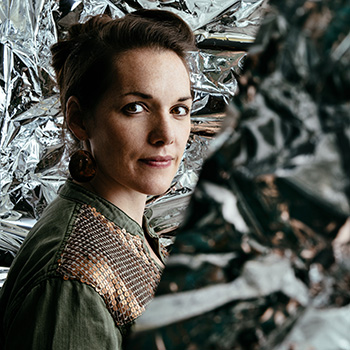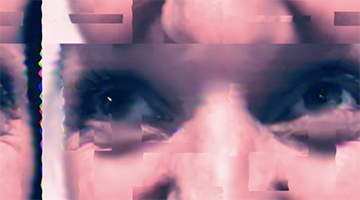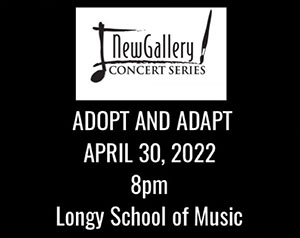“the Me you See” – Using Performance Art to Share a Personal Adoption Experience
Guest writer Maria Finkelmeier, a percussionist, composer, educator, and public artist, will be premiering her performance art, “the Me you See” along with several other new works by local composers as part of the New Gallery Concert Series Adopt and Adapt concert on Saturday, April 30 at 8:00 PM at the Longy School of Music of Bard College. Maria reached out to BPAR to share her story, remembering how therapy helped her during the process of finding her birth mother several years ago.

Maria Finkelmeier (Credit Adam DeTour)
I’ve always known that I was adopted. I’m not sure when or how my parents told me, but somehow they did it in a way that always made it a non-issue. I didn’t think or feel I was “unique” until I was much older and could understand the nuances and complexities of the adoption process. However, I did often wonder who my birth parents were—what they were up to at any given stage in life, or what they looked or sounded like—but it wasn’t until I was considering motherhood myself that I felt an overwhelming sense that I wanted to know my birth mom.
I also felt the overwhelming sense that I could not go through the process alone. While my immediate family was very supportive, the decision to search affected everyone in different ways, so I felt it was imperative to seek help from a professional. As a person who also often says to myself, “Oh, I’m fine, no worries," taking this leap into therapy was a big one—and I’m so happy that I did. The process helped me better understand my story, my identity, and my relationships.
I do recall one of KC’s suggestions was to “make some art depicting your story.” At the time that felt like running 5 marathons, but I’m proud to now have the opportunity, space, and support to create something reflective of my experiences.
When conceptualizing “the Me you See,” I thought about how everyone involved in my story at one point had imagined their own vision, each one quite unique based on their perspective. My parents imagined my birth parents, my birth mom imagined me, I imagined them, etc. . . . In many cases, the intensity around seeking a birth family is the understanding that an imagined vision may be very different from reality. I recall this fear deeply, and the need to take a leap of faith, accepting the unknown.
In 2017, I did seek out and meet my birth mom and half sister. In my case, the agency had kept up-to-date documentation, and once I contacted them with interest, I was connected with my birth mom via written letter within a week. I was (again) overwhelmed, and appreciative of the help through the emotional roller coaster from BPAR. I am grateful to share that my birth mom and half sister are wonderful, and our reconnection has allowed me to understand parts of my existence that I never thought I would uncover.
As with any human relationship, the more we are able to meet and connect, the less we rely on the “imagined” version of each other as we create real memories and understandings of one another.
Since “the Me you See” is written through the lens of this deeply personal adoption experience, it was a completely different process than composing something without any connection to my own life. To put it simply, writing this piece was HARD. I appreciated and was excited by Sarah Bob’s vision (director of the New Gallery Concert Series), but when I sat down to put pen to paper, my mind was overwhelmed and turned blank. How does one make tangible identities and/or realities that we’re still figuring out?
I do find that writing from such a personal perspective takes much more time, to sift through many ideas to land on the one that feels equally vulnerable and safe. Finding that balance is the real challenge, and manifests as many, many ideas being thrown out the door.
As we build up to the April 30 premiere, I’ve been able to spend time with the other composers who will be performing with me. Each of us has a very different connection to our adoption stories, and we spent a few Zoom sessions sharing and discussing how to shape the project. I appreciate that each of us has the space to approach the topic in our own way. The biggest inspiration was the difference in our stories and experiences; it led me to think about the concept of adoption, and the imagined characters in our lives in a more broad sense.

At the Adopt and Adapt concert, the audience will begin in the concert hall, then be able to explore simultaneous performances in various first floor rooms at the Longy School of Music at their own pace. After that, the dozen performers on the series, along with a number of volunteers will invite audience members to gather in the lobby by softly ringing wind chimes—a sound that will bring us all into a reflective space. The percussionists will perform a rhythmic groove on individual chimes, then leading everyone back into the concert hall to be greeted by the string quartet, a cuantro trio, piano, and percussion quartet on vibraphones and glockenspiels. I will invite the audience to listen to how the sound of each instrument resonates individually and collectively. How does each listener differ based on their own lived experiences and the imagined vision of the musicians around them? The work will also feature a video projection, lighting design, and live collaging by a visual artist. I’m really honored to be on the program with such a talented artistic roster!
Written by Maria Finkelmeier
Adopt and Adapt is made possible by funding from Live Arts Boston through The Boston Foundation. Tickets for the April 30, 2022 event are available online.
